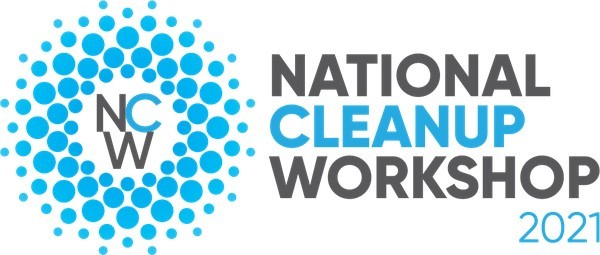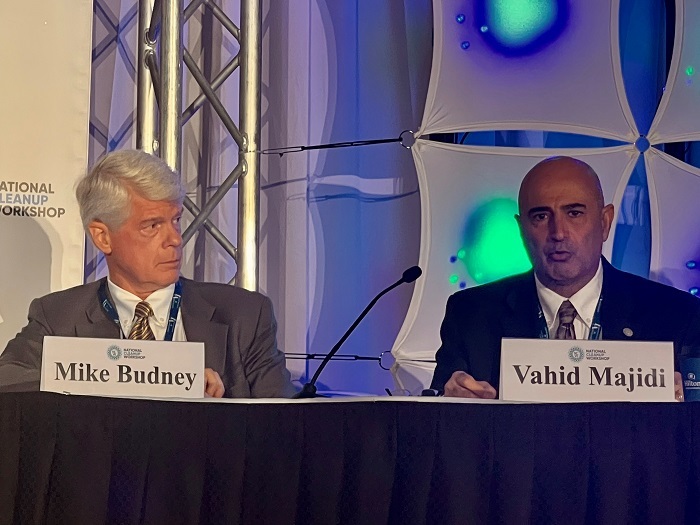 Mike Budney, manager of the Savannah River Site Operations Office, and Savannah River National Laboratory Director Vahid Majidi, detail the benefits being derived from the laboratory’s new status as a standalone business operation.
At SRS, manager Mike Budney said EM is benefiting from the new contract status of the Savannah River National Laboratory as a standalone entity, apart from the site’s main cleanup contractor. The arrangement has enhanced the lab’s ability to provide independent analyses, and to attract work to support other contractors and sites in the EM complex, he said.
Budney said the lab operator, Battelle Savannah River Alliance, has involved local universities in its efforts, expanding a pipeline to young talent and potential SRS job recruits. The lab also is a key participant in planning for the Advanced Manufacturing Collaborative (AMC), a facility that will serve as an innovation hub supporting research that can be adapted into modern manufacturing and industrial practices.
“That will be the place we can eventually see more transitions in technologies from the lab to industry,” Budney said of the AMC.
Click here to watch new EM videos on EM site missions.
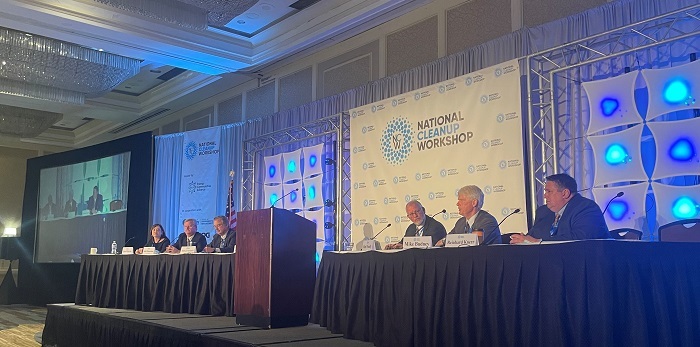 EM field office managers took part in a roundtable discussion during the 2021 National Cleanup Workshop in which they shared how EM maintained cleanup progress over the past two years despite challenges related to the COVID-19 pandemic.
Managers leading cleanup at several EM sites detailed how they have made significant progress in the EM mission over the past two years despite the challenges of the COVID-19 pandemic.
That was one of the key takeaways from a roundtable discussion at the 2021 National Cleanup Workshop held by the managers of the Oak Ridge Office of Environmental Management (OREM), Portsmouth/Paducah Project Office (PPPO), Carlsbad Field Office (CBFO), EM Los Alamos Field Office (EM-LA), Savannah River Site Operations Office and Environmental Management Consolidated Business Center (EMCBC).
The panelists provided insight into how they have navigated the pandemic and other challenges while ensuring progress in EM’s cleanup mission. They also agreed that EM’s strategic vision has enabled EM sites to maintain focus on completing important goals and milestones. EM’s Strategic Vision 2021-2031 is a blueprint to the program’s anticipated accomplishments over the next decade that will protect the public and environment.
Reinhard Knerr, CBFO manager, noted that EM’s Waste Isolation Pilot Plant (WIPP) was able to continue receiving transuranic waste shipments throughout the entire pandemic. Last month, CBFO marked receipt of the 13,000th waste shipment to WIPP, an important landmark in EM’s mission to clean up the country’s Cold War legacy.
Laura Wilkerson, OREM acting manager, highlighted Oak Ridge’s biggest accomplishment, which was, “without question, the completion of Vision 2020.” She noted that Oak Ridge achieved the ambitious goal at the height of the pandemic. Workers accomplished Vision 2020, an EM 2020 priority, by completing demolition of Oak Ridge's East Tennessee Technology Park, making it the first site in the world to remove an entire uranium enrichment complex.
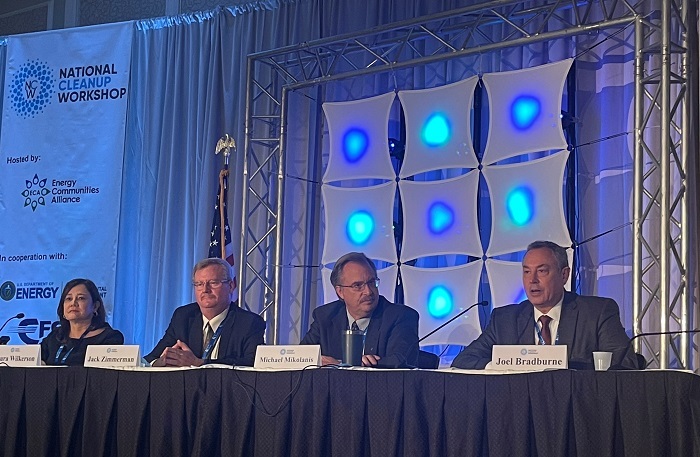 Participants in a roundtable discussion at the 2021 National Cleanup Workshop included, from left, Oak Ridge Office of Environmental Management Acting Manager Laura Wilkerson, Environmental Management Consolidated Business Center Director Jack Zimmerman, EM Los Alamos Field Office Manager Michael Mikolanis and Portsmouth/Paducah Project Office Manager Joel Bradburne.
Jack Zimmerman, EMCBC director, detailed successes at EMCBC sites over the past year, including demolition of the final DOE-owned buildings at the Energy Technology Engineering Center and the teardown of the High Flux Beam Reactor exhaust stack at Brookhaven National Laboratory, which resulted in a dramatic skyline change.
The Moab Uranium Mill Tailings Remedial Action (UMTRA) Project was able to maintain operations despite the pandemic, according to Zimmerman. In October, workers at the site accomplished an EM 2021 priority by successfully relocating another million tons of uranium mill tailings away from the Colorado River, bringing the cumulative total to 12 million tons permanently disposed.
“Even though we are dealing with smaller sites, we are not dealing with smaller problems,” Zimmerman said as he emphasized the significance of the EMCBC sites’ achievements.
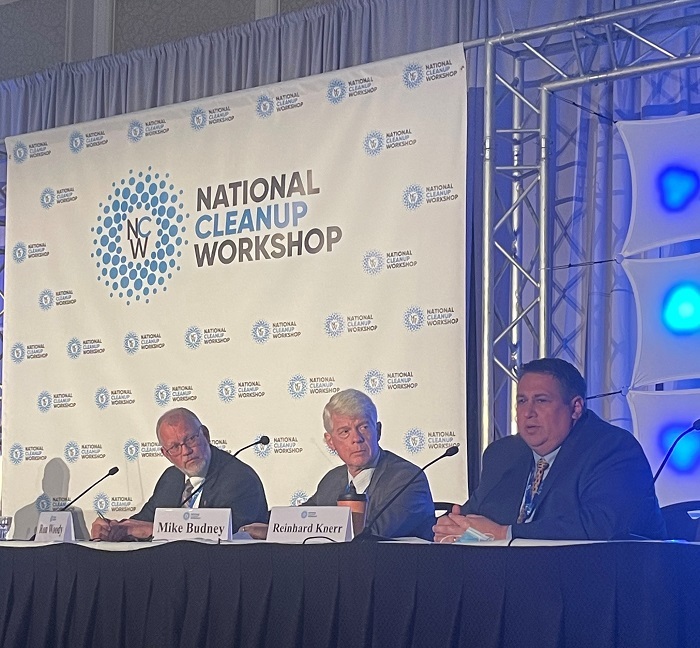 Ron Woody, far left, county executive of Roane County, Tennessee, and chair of Energy Communities Alliance, moderated a roundtable discussion with EM field office managers, including Mike Budney, center, with Savannah River Site Operations Office, and Reinhard Knerr with Carlsbad Field Office.
Roundtable moderator Ron Woody, county executive of Roane County, Tennessee, and chair of Energy Communities Alliance, emphasized the need for EM sites to be “investment worthy.”
Michael Mikolanis, the EM-LA manager, said the Los Alamos site is investment worthy, adding that he’s “really pleased and proud to see that I have an organization that is focused on reducing costs, accelerating the work and delivering results for the community.”
PPPO Manager Joel Bradburne highlighted the close relationships among PPPO and the Portsmouth, Ohio and Paducah, Kentucky sites, and how those relationships help ensure work gets done.
Click here to watch new EM videos on EM site missions.
 The Direct-Feed Low-Activity Waste (DFLAW) Program at the Hanford Site integrates individual projects, facilities and infrastructure upgrades, with involvement from all of Hanford’s contractors. Click here to view the full size of this image.
EM federal and contractor leadership from the Hanford Site provided an in-depth look at the Direct-Feed Low-Activity Waste (DFLAW) Program, and progress made toward immobilizing tank waste in glass through the process of vitrification during the 2021 National Cleanup Workshop.
Brian Vance, EM Office of River Protection and Richland Operations Office manager, led the panel discussion, which was conducted virtually. Vance introduced the DFLAW Program and the leaders who are working together toward the start of the tank waste treatment mission through teamwork and a collective commitment to excellence. “In addition to completing construction on the facilities that support DFLAW, the One Hanford team is continuing to shift our site mindset towards an operations-based culture, ready for 24/7 operations,” Vance said.
The DFLAW process starts at Hanford’s Tank Farms, where the waste delivery system will feed treated tank waste to Hanford’s Waste Treatment and Immobilization Plant ( WTP). John Eschenberg, president of Washington River Protection Solutions, explained Hanford’s Tank-Side Cesium Removal system and how it filters undissolved solids and cesium — which account for 99.9% of the radioactivity — from the low-activity tank waste before sending it to WTP to be vitrified for safe disposal. Valerie McCain, Bechtel National, Inc. WTP project manager, reported that her company has completed all construction and startup testing at the plant. She also highlighted progress made on hiring, training and qualifying workers who will operate the facility. Every DFLAW facility has been handed over to the commissioning and plant management teams, which will place components and systems into service and demonstrate the facilities are ready to treat the first tank waste by the end of 2023.
 |
|
Office of River Protection and Richland Operations Office Manager Brian Vance delivers an overview of Hanford tank waste treatment during a virtual session of the 2021 National Cleanup Workshop. |
The safe disposal of the vitrified waste canisters marks the end of the line for the waste. Scott Sax, president of Central Plateau Cleanup Company, described Hanford’s Integrated Disposal Facility as a site that currently includes two disposal cells engineered to protect the environment. Workers will monitor and collect runoff that reaches the liner at the bottom of the facility for safe treatment and disposal.
Throughout the process, essential services are critical to successful operations. Bob Wilkinson, president of Hanford Mission Integration Solutions, highlighted infrastructure that keeps the mission moving forward. Water, power, information technology and emergency services are just a few of the interdependent systems that support Hanford cleanup in a fundamentally different site operating environment.
David Reeploeg, executive director of Hanford Communities, works with legislative and community members to ensure the success of the Hanford cleanup mission. He emphasized how important it is, from the community’s perspective, to be moving forward with tank waste treatment. The One Hanford philosophy has guided DOE and contractors in working together to successfully begin the tank waste cleanup phase of the Hanford cleanup by the end of 2023.
Click here to watch new EM videos on EM site missions.
-Contributor: Jill Harvill
Kristen Ellis, left, EM acting director for regulatory, intergovernmental, and stakeholder engagement, moderates a discussion by the "Future of the EM Workforce" panel at the 2021 National Cleanup Workshop. Panelists pictured are Dennis Carr, executive vice president and chief operating officer of Savannah River Nuclear Solutions, and Kim Lebak, president of Newport News Nuclear BWXT-Los Alamos. Ellis also serves as EM’s senior advisor for STEM and talent acquisition.
Focusing on the future workforce is vital to the EM mission, according to panelists at the 2021 National Cleanup Workshop who discussed challenges and possible solutions in recruiting and retaining talent.
The future challenges are coming fast, speakers said, particularly at each DOE site. The Department will need more than just science, technology, engineering and mathematics (STEM) education to remain competitive and fill critical positions, they said.
Kristen Ellis, EM’s acting director for regulatory, intergovernmental, and stakeholder engagement, moderated the session, which included Mary Kruger, EM’s deputy assistant secretary for resource management; Kim Lebak, president of Newport News Nuclear BWXT-Los Alamos; Dennis Carr, executive vice president and chief operating officer of Savannah River Nuclear Solutions; and Rebecca Casper, mayor of Idaho Falls, Idaho.
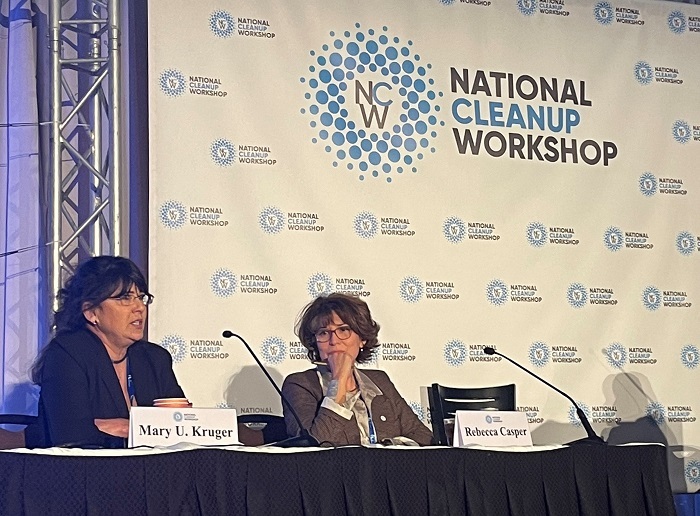 Mary Kruger, EM’s deputy assistant secretary for resource management, at left, and Rebecca Casper, mayor of Idaho Falls, served on the "Future of the EM Workforce" panel at the 2021 National Cleanup Workshop.
The panelists offered solutions to help attract, hire and retain qualified staff needed for important projects and sites. Those solutions included student loan forgiveness, increased money for incentives, working closely with subcontractors, and remote working.
Ellis, who is also EM’s senior advisor for STEM and talent acquisition, emphasized the importance of working with students on STEM issues, beginning as early as elementary school, as well as expanding EM’s Minority Serving Institution Partnership Program.
Click here to watch new EM videos on EM site missions.
EM has selected Joel Bradburne to serve as field manager of the Portsmouth/Paducah Project Office (PPPO) in Lexington, Kentucky.
In this role, Bradburne will oversee the deactivation and demolition of the former gaseous diffusion facilities at the Portsmouth, Ohio and Paducah, Kentucky sites, and the Depleted Uranium Hexafluoride (DUF6) Conversion Project, which includes operations at both locations.
Bradburne was named acting PPPO manager on July 31 this year. Prior to that, he served as PPPO deputy field manager. In that position, he provided leadership direction to the Lexington professional staff and site management, and served as manager of the DUF6 project.
“Joel’s experience managing primary projects at PPPO makes him uniquely qualified to serve in this role,” EM Senior Advisor William “Ike” White said. “We are looking forward to Joel’s continued commitment to cleanup progress at EM’s Portsmouth and Paducah sites, as well as the ongoing operations of the DUF6 plants.”
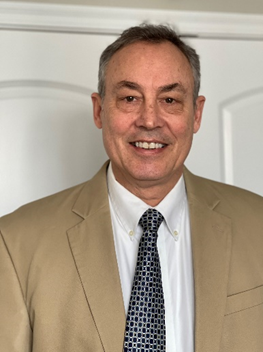 |
|
EM has named Joel Bradburne field manager of the Portsmouth/Paducah Project Office in Lexington, Kentucky. |
Before joining the PPPO office in Lexington, Bradburne was the Portsmouth Site lead for eight years, and was heavily involved in planning and execution of the current deactivation and demolition approach at the site.
Bradburne has more than 35 years of experience in government and commercial nuclear operations and cleanup. His DOE experience includes more than 20 years at numerous sites and projects.
Prior to moving to Portsmouth, Bradburne was a senior project manager with Nuclear Fuel Services in South Carolina. He held several management positions with Fluor Fernald, Inc., at the DOE Fernald Site near Cincinnati from 1994 to 2004. He also worked in shipyard and foreign nuclear site decommissioning.
Bradburne earned a bachelor’s degree in biology from Bridgewater College in Virginia and a master’s degree in environmental management from the University of Findlay in Ohio.
Click here to watch new EM videos on EM site missions.
|


